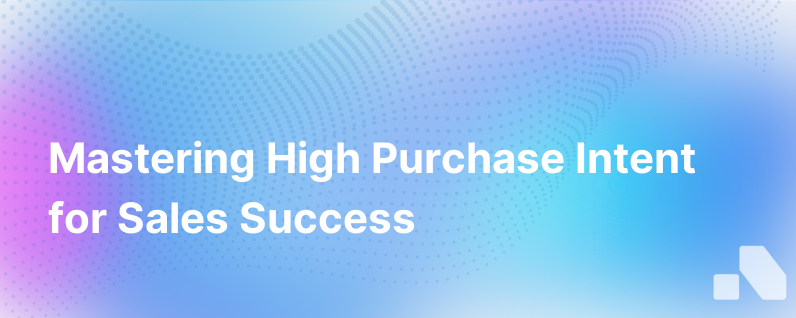High Purchase Intent
Published on September 24, 2023 by Sawyer Middeleer
Understanding High Purchase Intent: A Deep Dive for B2B Marketers
In the complex ecosystem of B2B marketing, identifying individuals or businesses that are actively looking to purchase your product or service – those with "high purchase intent" – is akin to finding a needle in a haystack. However, it's this very pursuit that underpins the success of marketing campaigns and strategies. Grasping the concept of high purchase intent is crucial for boosting conversion rates and achieving a formidable return on investment.
What is High Purchase Intent?
High purchase intent refers to the likelihood of a prospect being in the final stages of the buying process, ready to make a decision. They have recognized a problem or opportunity, considered possible solutions, and are evaluating your offering with serious consideration to purchase. These prospects have moved beyond mere interest or awareness; they have taken actions that signal readiness to invest in a solution.
Why High Purchase Intent Matters
Nurturing leads with high purchase intent is the pinnacle of sales effectiveness and marketing efficiency. These individuals are more likely to convert into customers, and their transactions often involve less resistance and shorter sales cycles. Recognizing and channeling effort into these high-intent entities allows for prioritization of resources toward the 'low-hanging fruit', driving revenue growth and enhancing the sales team's productivity.
Identifying High Purchase Intent
The first step toward capitalizing on high purchase intent is accurate identification. The digital footprints left by B2B buyers – from website interactions to social media engagement – are rich with clues.
Here’s how B2B marketers can spot high purchase intent signals:
- Behavioral Analytics: Website analytics offer insights into visitor behavior. Actions like downloading a whitepaper, spending a significant amount of time on product pages, or repeatedly visiting pricing information suggest a serious contemplation of your service or product.
- Lead Scoring: Assign numerical values to various actions and behaviors to quantify lead quality. Higher scores denote warmer, more intentional leads.
- Intent Data: Utilize third-party intent data providers to identify companies that are actively researching topics relevant to your products or services. Intent data can signal a company's entry into the buyer's journey, hinting at latent purchase intent.
- Engagement Metrics: High engagement on emails, particularly those that focus on product details, testimonials, case studies, or pricing, suggest that the prospect is evaluating the offering closely.
Understanding the Buyer's Journey
Achieving a high conversion rate among prospects with high purchase intent necessitates a nuanced comprehension of the B2B buyer's journey. Unlike B2C transactions, this journey can be prolonged, with multiple stakeholders to convince and a greater emphasis on ROI and value propositions.
Awareness Stage: At this initial phase, potential buyers are becoming aware of their challenge or an opportunity. Content aimed at educating and informing, like blog posts and eBooks, can attract these early-stage prospects.
Consideration Stage: Here, prospects have clearly defined their issue or opportunity and are considering various approaches or strategies to address it. Webinars, comparison guides, and case studies are valuable at this stage to demonstrate capability and expertise.
Decision Stage: In the final stage, buyers are selecting their vendor. Free trials, live demos, and consultations help to nurture those showing high purchase intent, tilting them towards making a purchase.
Fostering High Purchase Intent Leads
Nurturing leads that demonstrate high purchase intent is about timing, personalization, and relevance:
- Timely Follow-ups: Respond swiftly to high-intent behaviors like form submissions or product demo requests. Time is of the essence; delay may cool interest.
- Personalized Communication: Tailor your messages according to the information gathered about their pain points, industry, or business size.
- Value Proposition: Communicate a compelling value proposition. Show how your offering aligns with their objectives and needs.
- Sales and Marketing Alignment: Ensure your sales and marketing teams are seamlessly aligned, so high-intent leads experience a coherent journey from first touch to closing.
Using Technology to Harness High Purchase Intent
Modern marketing technology stack is instrumental in detecting and acting on high purchase intent:
- CRM Systems: Manage lead and customer data, providing a complete view of interactions and engagement.
- Marketing Automation: Score leads and automate personalized campaigns triggered by specific behaviors indicating high purchase intent.
- AI and Machine Learning: Employ advanced technologies to predict potential high-intent leads based on historical data and current interactions. For instance, Aomni’s AI platform analyzes real-time account research and competitive insights to help sales teams target high-intent accounts effectively.
Closing the Deal
Converting a high-purchase-intent lead requires more than just identifying them and their position in the buyer's journey. It's about ensuring that all your bases are covered – from engaging content to robust follow-up – throughout the sales process. You have to be prepared to deliver personalized, convincing content and conversations that address the prospect's unique needs, pain points, and decision-making criteria.
In conclusion, targeting prospects demonstrating high purchase intent is essential for efficient sales cycles and to maximize marketing ROI. By recognizing the signs and effectively nurturing these opportunities through personalized, timely engagement across an aligned sales and marketing front, B2B organizations can not only capture but capitalize on the readiness of such buyers to commit.